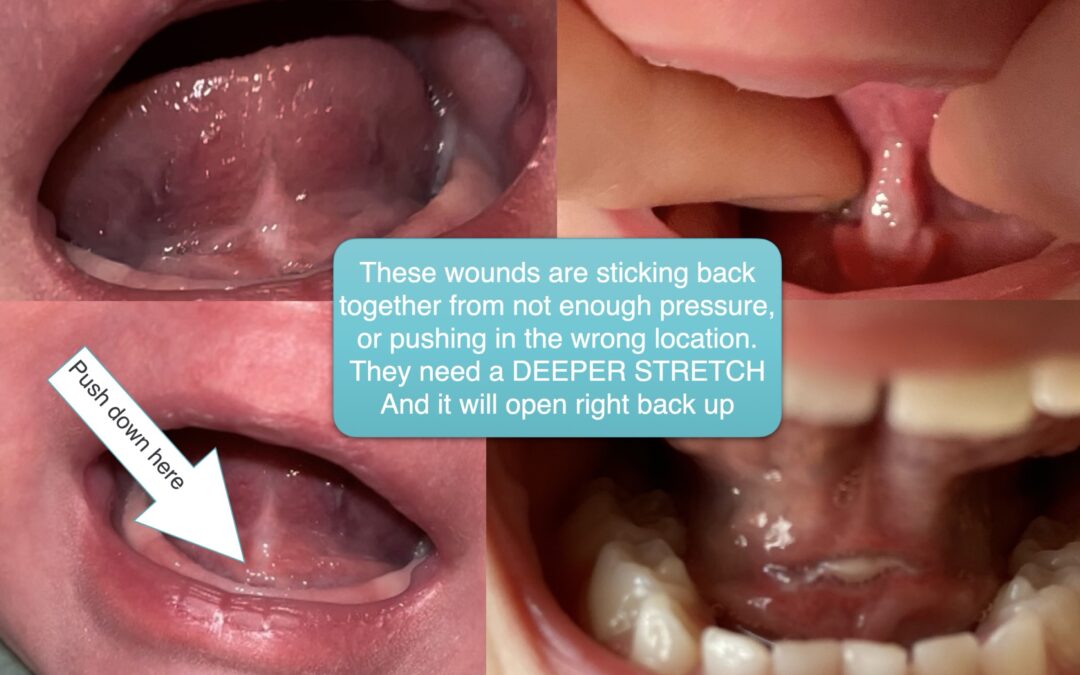First, what is a tongue-tie? A tongue-tie is really just a restricted tongue and does not have to be attached to-the-tip where you can’t move your tongue at all. In fact, there are two primary ways to tell if a child has a tongue-tie: appearance and symptoms/function.
If the string under the tongue is attached at or near the tip, this tongue is very restricted and will likely cause symptoms for that baby or child (or even adult). However, the tongue is often not attached at or near the tip, and the infant or child (again, an adult as well) could suffer from many tongue-tie symptoms like trouble nursing, bottle-feeding, eating, speaking, sleeping, or even breathing.
In those cases, the tongue may be moderately or mildly restricted, but if there are many symptoms present, the tongue is likely too tight for that individual person. Since these less obvious restrictions are harder to pick up and diagnose, they can go undiagnosed in infants for months, children for years, and adults for decades.
In fact, the true number of patients struggling with a restricted tongue that is causing symptoms is far greater than the often-reported 10% of people and is closer to 25% of patients (as we found in a study at our office and is corroborated by several other studies).
So the first way to tell if your child has a tongue-tie, is to look under his or her tongue. If it’s a baby, lift the tongue with your finger. If it’s a child or teen (or yourself!) ask them to lift their tongue up. Sticking the tongue out is the worst test to determine if a tongue is restricted. If the tongue is tied down, and can lift only a little bit, then you have a very significant restriction, and there are likely to be symptoms present (speech, slow eating, restless sleeping, mouth breathing, etc.) or an infant would have trouble latching, reflux, excessive gas, spit up, colic, etc.
The second way to tell is based on the symptoms. Many medical conditions are not picked up based on an obvious trait but rather a collection of symptoms that leads to the diagnosis. Tongue-tie is not different. If your child has slow eating, for example, they take a long time to eat, pack food in their cheeks, spit out food if it’s too hard to swallow, say they are full after a few bites, almost always that is not just a picky child. That collection of symptoms is a restricted tongue until proven otherwise. Now add to that speech issues, sleep issues like restless sleeping, mouth breathing, teeth grinding, snoring, headaches, hyperactivity, or a strong gag reflex, and your chances of tongue-tie have skyrocketed. A quick note: tongue-tie does not always cause speech issues, or painful nursing for babies, or sleeping issues. It often does, but the presentation is different for each child. Check this list of symptoms; if your child has more than a few, an evaluation is warranted.

Children with these symptoms need a proper assessment by a trained professional to rule out tongue-tie (again, the more checkmarks on our symptom sheet, the more likely they have one!). Sadly, contemporary tongue-tie diagnosis and treatment are not taught in medical or dental school or even in speech, lactation, or other professional programs. You really have to search for someone who has taken recent classes on the subject and can help identify it. That’s why we are here. We help educate providers to identify and treat the condition and, of course, treat patients from around the world in our clinic. We would love to connect with you and help your family not just to survive but to thrive. We do the consultation and the treatment (if needed) in the same appointment, with just a numbing jelly and the most advanced surgical CO2 laser available. It only takes around 15 seconds to release a tongue-tie that can hold kids back in so many ways. Just send us a message, fill out the quiz, or give us a call, and we will be happy to help guide you through your search.





